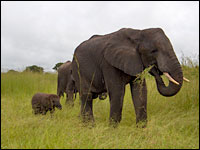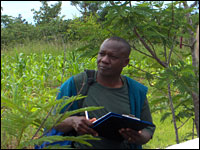In the 1970s, one of the densest populations of elephants on the African continent roamed the Luangwa Valley of Zambia. By the end of the next decade, massive poaching for the ivory trade had decimated herds throughout Africa, and the elephant population in North Luangwa National Park had plunged from 17,000 to 1,300. Though international authorities shut down the ivory trade in 1990, poaching remained a way of life for many in the Luangwa Valley.

Hammer Simwinga.
Photo: Goldman Environmental Prize.
Hammerskjoeld Simwinga — known as Hammer — has helped to change that. Simwinga, who grew up in the valley, began his work with the North Luangwa Conservation Project, founded by American zoologists Mark and Delia Owens. With small loans, Simwinga encouraged villagers to open general stores and grinding mills, providing economic alternatives to poaching. He also helped farmers switch to protein-rich, high-yield crops, reducing their dependence on bushmeat.
When the NLCP ran afoul of the Zambian government in the mid-1990s and was forced to drop funding for its local development programs, Simwinga persisted. With no salary, no title, and no transportation beyond a bicycle, Simwinga continued to build local support for conservation, eventually forming a new Zambian NGO. His programs now reach more than 35,000 people, and income in the region has increased a hundredfold. Elephant poaching in the park is almost entirely controlled.
Simwinga, 45, was awarded one of six 2007 Goldman Environmental Prizes at a ceremony in San Francisco on April 23. The award money, he says, will help him expand his work throughout the Luangwa Valley. He spoke to Grist from San Francisco.
What are the biggest threats to wildlife and human welfare in the valley?
In the past it has been the unsustainable harvesting of resources from the national park, that is, the killing of the animals. On the plateau, which serves as a buffer zone for the national park, people have been unsustainably using trees — our form of agriculture is slash and burn, so people will cut trees, collect them, and burn them. So the environment in the valley and on the plateau has been under great threat because of human interference.
How did you get involved with the North Luangwa Conservation Project?
Initially, [the Owenses] were doing a study [of lions] in the valley. Their study was interrupted because of the heavy poaching, so they decided to add another thrust to their project — a community development program for wildlife conservation. When I was hired on, my role was to introduce a more sustainable life strategy within the community, addressing hunger and poverty so that the wildlife would be given a chance to regenerate.
What attracted you to this sort of work?

It’s a tusk job, but somebody’s gotta do it.
Photo: John Antonelli
I knew that the rate at which we were killing animals was not going to see us through, that [if we had continued] we would not see North Luangwa Park in existence today. The [human] population was growing and more animals were dying, so we had to inflict more pressure on the limited resources we had. So I knew we had to come up with a program to protect the park, so that other people would have the opportunity to see the goodness and wonders of nature and what it can give.
We’ve also been hearing that in other countries, a national park can quickly improve local economy, so we’re working toward that. We’re happy that now the park itself is repopulated, regenerated, that we have seen tourists coming into our area, bringing a form of employment to our guides, and we’ve also been selling a few crafts to them. So that has motivated us.
What were the most effective strategies you used to reduce poaching?
When I looked at the whole thing, I found that the human being was the most important partner — the local people needed to be given an opportunity to conserve. So we introduced small businesses [and] technologies like beekeeping, so people could continue using the forest, but in a sustainable way. Involving the people in conservation reduces the pressure on the government [to protect the park]. If everyone around the park is involved, and another person tries to trespass into the park, people will be cautioning him or restricting him.
I understand that you continued your work even after the NLCP cut funding for its village development programs. What was that like?
I knew that it was very important to keep working, because if you have that local support, conservation becomes so much easier. The only things that were difficult [without funding] were logistics, things like transportation. I did a lot of walking, but I developed an extension system where trained local community members continued working when I was not there. This helped a lot, to establish these institutions within the community.
Did you experience opposition or criticism from the communities you work with?
Yes, but in North Luangwa, people have seen the benefit, and they’re our greatest supporters. From the people who are more involved in the illegal activities, there’s a lot of opposition. We had of course threats from commercial poachers who didn’t want our influence in the villages. But we didn’t relent, and we also managed to get friends along the way.
What are the greatest challenges you still face?

Hammer time.
Photo: John Antonelli
Within my district we have three national parks, and two of those are still under threat. I’m happy to report that the North Luangwa has been rehabilitated and the community is now fully aware of the importance of conserving. But I have another, bigger challenge in the other part of the district — there’s another park that is quite rich in unique habitats, but it’s being trespassed, and people have no other source of income. More and more youths are involved in illegal hunting. I was invited by the community to introduce this program — they are waiting for it — but because of limited resources I was unable to heed their invitation.
What does this prize mean to you?
It means that this great work has to continue. It means we have to reach more people, cover more areas, and do more research on what other alternatives can quickly expand the rural economy so pressure is reduced on the already diminishing resources of the world.
I think this award will bring me into the limelight, so that I can talk more about the environment — especially global warming, which has affected us in Africa, particularly in Zambia. In the last six years we’ve seen the rainy season shortening up — we used to have a prolonged season, which we needed for crops like maize and cassava. Year after year, we’re having reduced yields, and our seed security is being threatened.
I know I’ll have attention from the local people and the local media, so this will be an opportunity for me to mention some of these important things that we should be taking action on now.

